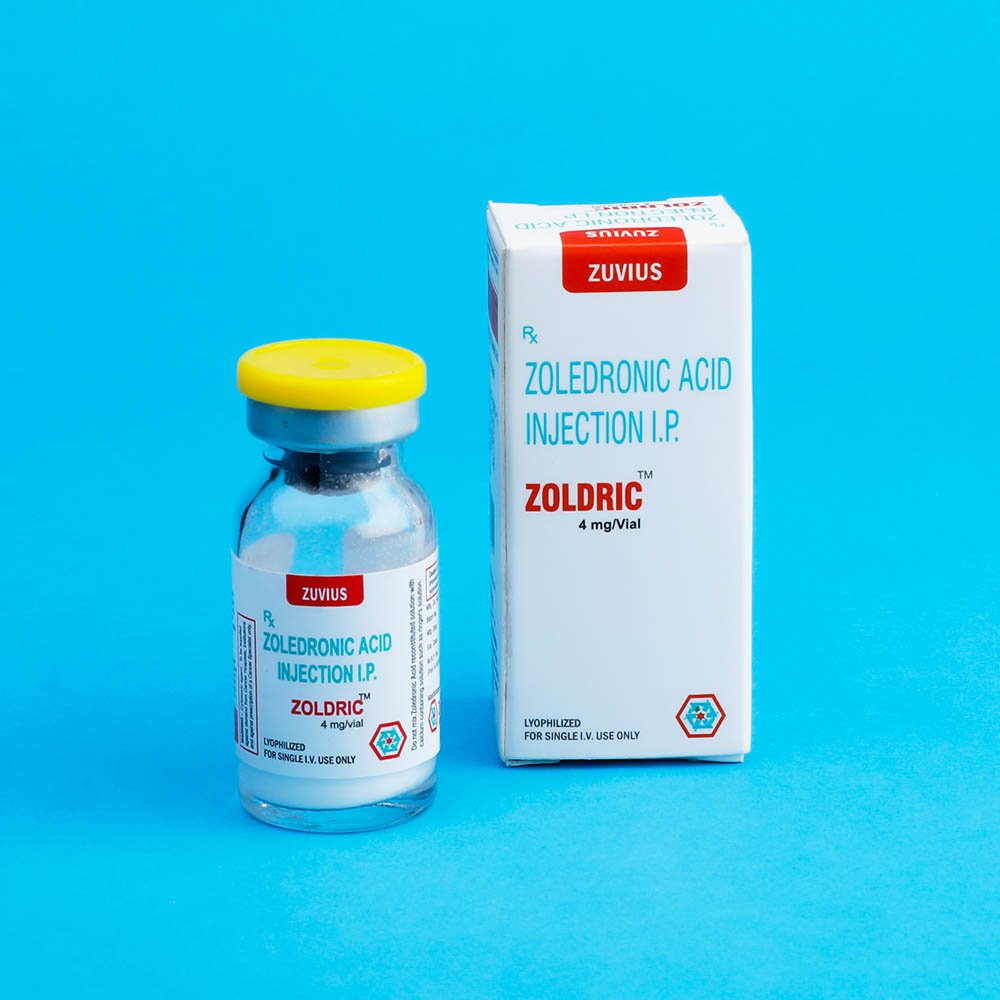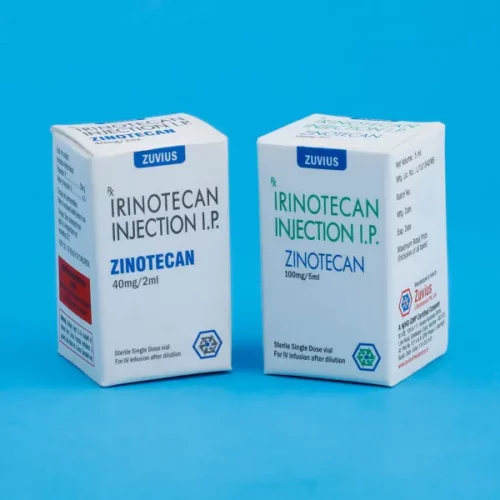Zoldric-Zoledronic Acid Inj 4 mg
Zoledronic Acid
Strength: 4mg
Pack Size: 1 vial
Drug Class: Bisphosphonate Derivatives, Calcium Metabolism Modifiers
Dosage and Administration:
Vials of Zoledronic concentrate for infusion contain overfill allowing for the withdrawal of 5 mL of concentrate (equivalent to 4 mg zoledronic acid). This concentrate should immediately be diluted in 100 mL of sterile 0.9% Sodium Chloride, USP, or 5% Dextrose Injection, USP, following proper aseptic technique, and administered to the patient by infusion. Do not store undiluted concentrate in a syringe, to avoid inadvertent injection.To prepare reduced doses for patients with baseline CrCl less than or equal to 60 mL/min, withdraw the specified volume of the Zoledronic concentrate from the vial for the dose required.
The withdrawn concentrate must be diluted in 100 mL of sterile 0.9% Sodium Chloride, USP, or 5% Dextrose Injection, USP.
If not used immediately after dilution with infusion media, for microbiological integrity, the solution should be refrigerated at 2°C–8°C (36°F–46°F). The refrigerated solution should then be equilibrated to room temperature prior to administration. The total time between dilution, storage in the refrigerator, and end of administration must not exceed 24 hours.
Due to the risk of clinically significant deterioration in renal function, which may progress to renal failure, single doses of Zoledronic should not exceed 4 mg and the duration of infusion should be no less than 15 minutes In the trials and in postmarketing experience, renal deterioration, progression to renal failure and dialysis, have occurred in patients, including those treated with the approved dose of 4 mg infused over 15 minutes. There have been instances of this occurring after the initial Zoledronic dose.
Cold Storage: yes
Zoledronic acid, a bisphosphonic acid which is an inhibitor of osteoclastic bone resorption. Zoledronic acid is designated chemically as (1-Hydroxy-2-imidazol-1-yl-phosphonoethyl) phosphonic acid monohydrate and its structural formula is:
 |
Zoledronic acid is a white crystalline powder. Its molecular formula is C5H10N2O7P2•H2O and its molar mass is 290.1g/mol. Zoledronic acid is highly soluble in 0.1N sodium hydroxide solution, sparingly soluble in water and 0.1N hydrochloric acid, and practically insoluble in organic solvents. The pH of a 0.7% solution of zoledronic acid in water is approximately 2.0. Zoledronic acid is available in 100 mL bottles as a sterile liquid ready-to-use solution for intravenous infusion and in 5 mL vials as a sterile liquid concentrate solution for intravenous infusion.
Hypercalcemia Of Malignancy
Zoledronic is indicated for the treatment of hypercalcemia of malignancy defined as an albumin-corrected calcium (cCa) of greater than or equal to 12 mg/dL [3.0 mmol/L] using the formula: cCa in mg/dL=Ca in mg/dL + 0.8 (4.0 g/dL -patient albumin [g/dL]).
Multiple Myeloma And Bone Metastases Of Solid Tumors
Zoledronic is indicated for the treatment of patients with multiple myeloma and patients with documented bone metastases from solid tumors, in conjunction with standard antineoplastic therapy. Prostate cancer should have progressed after treatment with at least one hormonal therapy.
Important Limitation Of Use
The safety and efficacy of Zoledronic in the treatment of hypercalcemia associated with hyperparathyroidism or with other nontumor-related conditions have not been established.
Osteoporosis is a significant cause of morbidity and mortality in the elderly and an important public health issue. Bisphosphonates are the primary treatment options for osteoporosis. The oral administration of bisphosphonates may result in poor patient compliance and thence reduced treatment efficacy. Intravenously administered bisphosphonates may therefore show better treatment efficacy. We have carried out a meta-analysis to evaluate the efficacy of zoledronic acid treatment for osteoporosis in both men and women with either vertebral or non-vertebral fracture. Material and methods: Randomized controlled trials with zoledronic acid treatment for osteoporosis were retrieved from PubMed, EMBASE and clinicaltrials.gov. The risk ratio with 95% confidence interval (RR, 95% CI) was calculated to evaluate the effect of zoledronic acid treatment on incidence of fracture. Data on changes in bone mineral density (BMD) following zoledronic acid (ZOL) treatment was also extracted. STATA software was used for all the statistical analyses. Results:Significant reduction in the incidence of both vertebral and nonvertebral fracture was observed following ZOL treatment, as seen from the values for RR with 95% CI (RR 0.24 and 95% CI 0.15 to 0.40 for vertebral fractures; RR 0.76 and 95% CI 0.67 to 0.86 for nonvertebral fractures). BMD was also seen to be increased after ZOL treatment.Conclusion: Ourmeta-analysis showed that zoledronic acid was effective in reducing the incidence of vertebral fractures as well as nonvertebral fractures, including hip fractures. Significant increase in bone mineral density (BMD) was also observed in patients administered ZOL as compared to placebo.
- Patients should be informed of the importance of good dental hygiene, routine dental care and regular dental check-ups.
- Patients should be advised to immediately tell their doctor about any oral symptoms such as loosening of a tooth, pain, swelling, or non-healing of sores or discharge during treatment with Zoledronic.
- Zoledronic should not be given if the patient is pregnant or plans to become pregnant, or if she is breastfeeding.
Patients With Asthma
While not observed in clinical trials with Zoledronic, there have been reports of bronchoconstriction in aspirin-sensitive patients receiving bisphosphonates.
Hepatic Impairment
Only limited clinical data are available for use of Zoledronic to treat hypercalcemia of malignancy in patients with hepatic insufficiency, and these data are not adequate to provide guidance on dosage selection or how to safely use Zoledronic in these patients.
Use In Pregnancy
Bisphosphonates, such as Zoledronic, are incorporated into the bone matrix, from where they are gradually released over periods of weeks to years. There may be a risk of fetal harm (e.g., skeletal and other abnormalities) if a woman becomes pregnant after completing a course of bisphosphonate therapy.
Zoledronic may cause fetal harm when administered to a pregnant woman. In reproductive studies in pregnant rats, subcutaneous doses equivalent to 2.4 or 4.8 times the human systemic exposure resulted in pre-and postimplantation losses, decreases in viable fetuses and fetal skeletal, visceral, and external malformations. There are no adequate and well controlled studies in pregnant women. If this drug is used during pregnancy, or if the patient becomes pregnant while taking this drug, the patient should be apprised of the potential hazard to a fetus.









